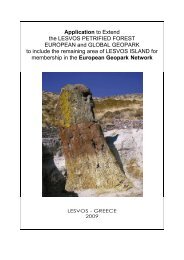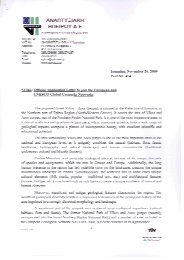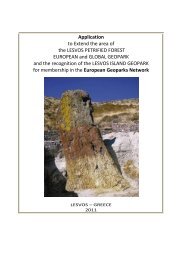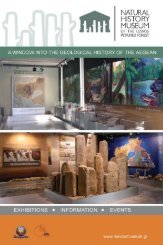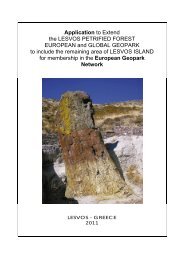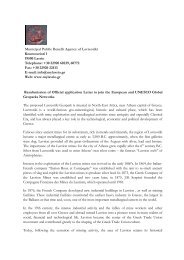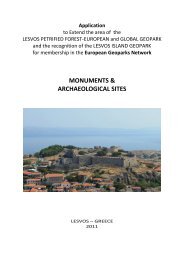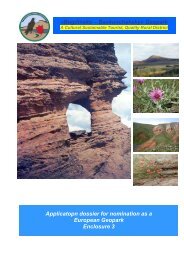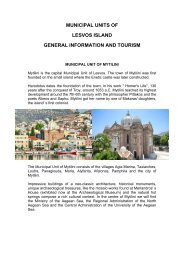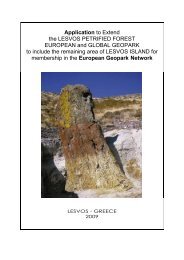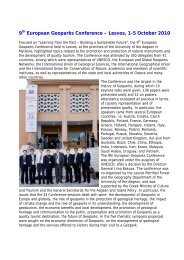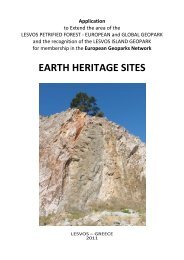Application to Extend the area of the LESVOS PETRIFIED FOREST ...
Application to Extend the area of the LESVOS PETRIFIED FOREST ...
Application to Extend the area of the LESVOS PETRIFIED FOREST ...
Create successful ePaper yourself
Turn your PDF publications into a flip-book with our unique Google optimized e-Paper software.
The Oligocene‐Miocene volcanic rocks <strong>of</strong> Lesvos are shoshonitic, with only minor interbedded<br />
calc‐alkaline andesites. There was minor earlier (21.5 M.a.) and later (16.5 M.a.) calc‐alkaline<br />
volcanism. Several volcanic formations can be distinguished:<br />
• The Eressos Formation is <strong>the</strong> oldest igneous formation, composed by porphyritic<br />
andesites interbedded with agglomerate and volcaniclastic rocks, dated at 21.5 M.a., by<br />
Pe‐Piper & Piper (1993). These lavas are 3 <strong>to</strong> 4 M.a., older than <strong>the</strong> main volcanic<br />
sequence <strong>of</strong> Lesvos.<br />
• The Skoutaros Formation is a normally magnetised sequence <strong>of</strong> andesite and basalt flow<br />
approximately synchronous with Sigri pyroclastics and Polychni<strong>to</strong>s ingnimbrite. In <strong>the</strong><br />
upper part <strong>of</strong> <strong>the</strong> formation pyroxene andesite lavas interbedded with hornblende‐<br />
biotite dacite lavas and felsic pyroclastic rocks <strong>of</strong> Sigri pyroclastic Formation.<br />
• The Sigri pyroclastics, thickest in <strong>the</strong> west <strong>of</strong> <strong>the</strong> island, are connected with <strong>the</strong><br />
development <strong>of</strong> <strong>the</strong> Petrified forest and are overlain by several sheets <strong>of</strong> <strong>the</strong> Polichni<strong>to</strong>s<br />
ignimbrite. The Kapi rhyolite domes are <strong>of</strong> approximately <strong>the</strong> same age, <strong>of</strong> about 17.0<br />
M.a.<br />
• The Polychni<strong>to</strong>s ignimbrites occur in correlable units 5‐30 m thick. Each unit has an<br />
upward decrease in size <strong>of</strong> lithic tephra, <strong>of</strong>ten poor welding at <strong>the</strong> base. Commonly an<br />
abundance <strong>of</strong> glass lenticules or obsidian are present near <strong>the</strong> base, and good columnar<br />
jointing exists at <strong>the</strong> <strong>to</strong>p <strong>of</strong> <strong>the</strong> unit. They are believed <strong>to</strong> be cooling units. The<br />
ignimbrites thin out against both metamorphic basement highs, and <strong>the</strong> main volcanic<br />
chain (where <strong>the</strong>y interbed with volcani‐clastic conglomerate).<br />
• The Skalochorion Formation lay in‐<br />
between <strong>the</strong> lower Skoutaros Formation<br />
and <strong>the</strong> upper Sykaminea lavas,<br />
composed by reversely magnetised<br />
intermediate lavas and contain feldspar<br />
megacrysts, commonly associated with<br />
mafic xenoliths.<br />
• The Sykaminea Formation dominates in<br />
central Lesvos and comprise a reversely<br />
magnetised stra<strong>to</strong>volcanic sequence <strong>of</strong><br />
andesites, dacites and rare rhyolitic<br />
pyroclastics, dated at 17.3 M.a. (Pe‐Piper<br />
1980).<br />
• The Mytilene Formation, was defined by<br />
Pe‐Piper (1978; 1980) as local basalt<br />
Panagia Gorgona ‐ Volcanic rocks<br />
flows that Prager (1966) claimed <strong>to</strong> overlay Pontian marls. New radiometric data<br />
indicate that <strong>the</strong> Mytilene formation is part <strong>of</strong> <strong>the</strong> main sequence <strong>of</strong> <strong>the</strong> volcanic activity<br />
in Lesvos, dated at 16.8 M.a. (Pe‐Piper & Piper 1993), (Borsi, et al. 1972.).<br />
• Meso<strong>to</strong>pos dykes, dated by Pe‐Piper (1978) at 16.2 M.a., are widespread in western<br />
Lesvos. Volcanic equivalents are rare or absent.<br />
The impressive in volume and time duration (21.5‐16.2 M.a.) volcanic activity in <strong>the</strong> <strong>area</strong> left a<br />
large number <strong>of</strong> active surface <strong>the</strong>rmal manifestations and include hydro<strong>the</strong>rmal alterations.<br />
6



